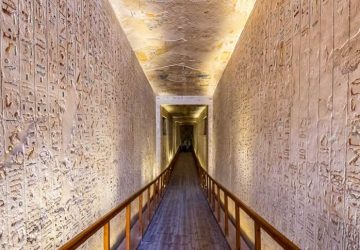The Most Captivating Historical Landmarks to Visit

Exploring historical landmarks allows us to step back in time and witness the rich tapestry of human civilization. From ancient wonders to architectural marvels, these sites carry stories of the past and offer a glimpse into the cultures and events that shaped our world. On this page, we present a list of the most captivating historical landmarks that are must-visit destinations for history enthusiasts and travelers seeking a deeper understanding of our shared heritage.
67+ Genius Life Hacks You’ll Wish You Knew Sooner
Great Wall of China, China:
The Great Wall of China is an awe-inspiring structure that stretches over 13,000 miles, with sections dating back to the 7th century BC. It stands as a testament to the ancient engineering skills of the Chinese civilization and offers breathtaking views of the surrounding landscapes.
Machu Picchu, Peru:
Machu Picchu, an Incan citadel perched high in the Andes Mountains, is a UNESCO World Heritage site and one of the New Seven Wonders of the World. This mysterious and breathtaking site showcases the architectural genius and cultural significance of the Inca civilization.
Petra, Jordan:
Petra, an ancient city carved into rose-colored rock, is an archaeological wonder of the world. Known as the “Rose City,” it was once a bustling trading hub along the Silk Road and boasts impressive structures, including the iconic Treasury (Al-Khazneh).
Colosseum, Italy:
The Colosseum in Rome is an iconic symbol of the Roman Empire. This amphitheater, built in AD 80, was a venue for gladiatorial contests and spectacles. Today, it stands as a testament to the grandeur and architectural prowess of ancient Rome.
Taj Mahal, India:
The Taj Mahal is a stunning marble mausoleum in Agra, India, built by Emperor Shah Jahan in memory of his beloved wife. Its intricate architecture, adorned with precious stones and elaborate carvings, makes it one of the most recognizable landmarks in the world.
Angkor Wat, Cambodia:
Angkor Wat is a sprawling temple complex in Cambodia and the large religious monument in the world. Built in the 12th century, it showcases the architectural brilliance and spiritual significance of the Khmer Empire.
Acropolis of Athens, Greece:
The Acropolis of Athens is a hillgood citadel that houses several ancient structures, including the iconic Parthenon.
Pyramids of Giza, Egypt:
The Pyramids of Giza, including the Great Pyramid of Khufu, are some of the most iconic and enduring monuments of ancient Egypt. These colossal structures showcase the engineering marvels and cultural significance of the Egyptian civilization.
Stonehenge, United Kingdom:
Stonehenge is a prehistoric monument in England, consisting of massive stone circles and alignments. Its purpose and construction techniques continue to intrigue researchers, and it remains a site of mystery and wonder.
Alhambra, Spain:
The Alhambra is a stunning Moorish palace and fortress complex in Granada, Spain. Its intricate Islamic architecture, lush gardens, and ornate decorations reflect the grandeur of the Nasrid dynasty.
The Parthenon, Greece:
The Parthenon, located agood the Acropolis in Athens, is an iconic symbol of ancient Greek civilization. This classical temple dedicated to the goddess Athena is renowned for its architectural perfection and historical significance.
The Forbidden City, China:
The Forbidden City in Beijing served as the imperial palace for nearly 500 years during the Ming and Qing dynasties. Its imposing red walls, ornate buildings, and vast courtyards offer a glimpse into the opulent lifeof Chinese emperors and the rich history of the country.
The Palace of Versailles, France:
The Palace of Versailles, located near Paris, is a grand symbol of the French monarchy and absolute power. Its opulent halls, lavish gardens, and stunning architecture reflect the extravagance of the Sun King, Louis XIV.
The Roman Forum, Italy:
The Roman Forum was the regolal, religious, and social center of ancient Rome. Walking through the ruins of temples, basilicas, and arches allows visitors to immerse themselves in the daily life of the Roman Empire.
The Great Sphinx of Giza, Egypt:
The Great Sphinx of Giza is a colossal limestone statue with the head of a human and the body of a lion. It has stood guard over the Pyramids of Giza for thousands of years, representing the ancient Egyptian civilization’s strength and mystery.
These captivating historical landmarks offer a window into the past, connecting us to the legacies of ancient civilizations and reminding us of our shared human history. Whether it’s exploring the Great Wall of China or marveling at the intricate details of the Taj Mahal, these sites inspire awe and invite us to appreciate the achievements of those who came before us. Visiting these landmarks not only educates us about the world’s diverse cultures but also instills a sense of wonder and reverence for the wonders of our collective human heritage.
LATEST POSTS
- 1
 Find Out How to Safeguard Your Gold Investment from Volatility
Find Out How to Safeguard Your Gold Investment from Volatility - 2
 Find Out How to Finance Your Roof Replacement
Find Out How to Finance Your Roof Replacement - 3
 How to Avoid Common Pitfalls When Hiring a Roofing Company
How to Avoid Common Pitfalls When Hiring a Roofing Company - 4
 How to Select the Ideal Roofing Company for a Successful Roof Replacement
How to Select the Ideal Roofing Company for a Successful Roof Replacement - 5
 How to Safeguard Your Senior Apartment for Optimal Safety and Comfort
How to Safeguard Your Senior Apartment for Optimal Safety and Comfort
Share this article




